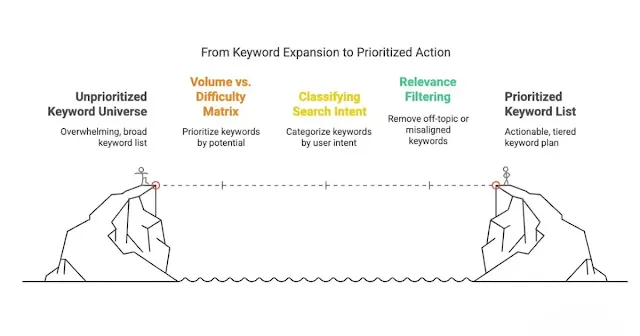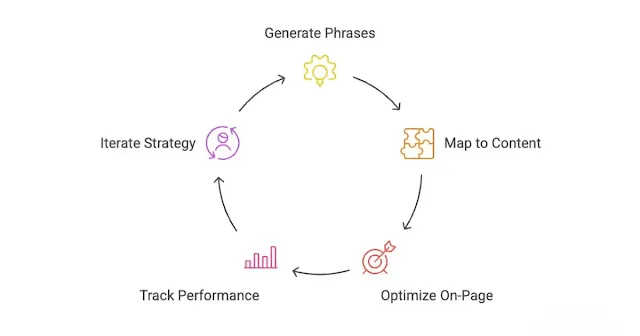Have you ever poured your heart into a blog post, meticulously crafting every sentence, only to watch it languish in the depths of search engine results? At BuzzSpot, we've felt that sting too.
I recall spending hours perfecting a piece I was sure would resonate, but it barely made a ripple. The disappointment was palpable. That's when I stumbled upon the SEO SEAL Method, a structured approach to keyword research that promised clarity and results.
Implementing this method was a game-changer. Suddenly, my content started to surface, attracting the audience it deserved. The SEO SEAL Method didn't just improve my rankings; it reignited my passion for blogging.
In this article, we'll delve into the four pillars of the SEO SEAL Method: Seed, Expand, Analyze, and Long-Tail. Whether you're a seasoned blogger or just starting out, this framework can revolutionize your approach to SEO.
 |
| SEO SEAL Method |
Introduction to the SEO SEAL Method
In the ever-evolving landscape of digital marketing, understanding and implementing effective SEO strategies is paramount. One such strategy that has gained traction among bloggers and content creators is the SEO SEAL Method. This structured approach to keyword research and content optimization is designed to enhance visibility and drive organic traffic.
 |
| What is the SEO SEAL Method? |
What is the SEO SEAL Method?
The SEO SEAL Method is an acronym that stands for:
- Seed: Identifying core keywords that represent the primary topics of your content.
- Expand: Broadening your keyword list by exploring related terms and phrases.
- Analyze: Evaluating the potential of each keyword based on factors like search volume and competition.
- Long-Tail: Focusing on specific, longer keyword phrases that target niche segments of your audience.
This method provides a clear roadmap for content creators to follow, ensuring that their efforts align with what users are actively searching for.
Why Adopt the SEO SEAL Method?
Implementing the SEO SEAL Method offers several benefits:
- Structured Approach: It breaks down the complex process of SEO into manageable steps.
- Enhanced Visibility: By targeting the right keywords, your content is more likely to appear in relevant search results.
- Audience Alignment: Focusing on long-tail keywords helps attract a more targeted and engaged audience.
By embracing this method, bloggers can move beyond guesswork and adopt a data-driven strategy that resonates with their audience and meets search engine criteria.
SEO SEAL Method: 4 Proven Steps to Boost Traffic
The SEO SEAL Method; which stands for Seed → Expand → Analyze → Long-Tail offers a comprehensive, step-by-step framework for developing a powerful and results-driven keyword strategy. Instead of relying on guesswork or randomly chosen keywords, this method provides a clear and structured approach that empowers marketers, bloggers, and content creators to uncover high-impact search terms that attract precisely the right audience.
Ready to unlock the full potential of your keyword strategy?
Discover how each step of the SEO SEAL Method works in detail. Learn how to generate powerful seed keywords, expand your reach with smart research, analyze data like a pro, and zero in on high-converting long-tail phrases.
Join us as we dive into each step and create a keyword strategy that truly drives results.
Step 1: Seed – Identifying Your Core Keywords
Every successful SEO strategy begins with a strong foundation, and in the SEO SEAL Method, that foundation is the "Seed" phase. This initial step involves pinpointing the primary keywords that encapsulate your website's core topics or offerings.
 |
| Identifying Your Core Keywords |
What Are Seed Keywords?
Seed keywords, often referred to as root or primary keywords, are concise terms (typically one or two words) that broadly define your niche or industry. For instance, if your blog focuses on healthy recipes, seed keywords might include "nutrition," "healthy eating," or "meal planning." These terms serve as the starting point for more in-depth keyword research, guiding the development of content that aligns with your audience's interests .
Why Are Seed Keywords Important?
Identifying effective seed keywords is crucial because they:
- Establish Relevance: They help search engines understand the primary focus of your content.
- Guide Content Creation: They inform the topics you cover, ensuring consistency and coherence.
- Facilitate Keyword Expansion: They act as a base from which you can discover related long-tail keywords and phrases.
By starting with well-chosen seed keywords, you lay the groundwork for a structured and effective SEO strategy.
How to Identify Your Seed Keywords?
Here are some practical steps to determine your seed keywords:
- Reflect on Your Niche: Consider the main themes and topics your blog or website addresses.
- Analyze Competitors: Review similar websites or blogs to see which keywords they target.
- Use Keyword Research Tools: Tools like Google Keyword Planner or Ubersuggest can help identify popular terms related to your niche.
- Consider Your Audience: Think about the terms your target audience might use when searching for content in your niche.
By systematically identifying your seed keywords, you set the stage for the subsequent phases of the SEO SEAL Method, ensuring a cohesive and targeted approach to your content strategy.
Step 2: Expand – Broadening Your Keyword Horizons
With your seed keywords identified, the next phase in the SEO SEAL Method is "Expand." This step involves generating a comprehensive list of related keywords and phrases that stem from your initial seed terms. Expanding your keyword list allows you to capture a wider array of search queries, catering to various user intents and increasing your content's visibility.
 |
| Broadening Your Keyword Horizons |
Why Expand Your Keyword List?
Expanding your keyword list is crucial because:
- Captures Diverse Search Intents: Users may search for the same topic using different phrases. A broader keyword list ensures you address these variations.
- Identifies Long-Tail Opportunities: Long-tail keywords, which are more specific and often less competitive, can drive targeted traffic to your site.
- Enhances Content Depth: A diverse keyword set allows you to create comprehensive content that thoroughly covers a topic.
Techniques for Expanding Your Keyword List
Here are some effective methods to expand your keyword list:
- Use Google's Autocomplete and Related Searches: Start typing your seed keyword into Google's search bar and observe the autocomplete suggestions. After searching, scroll to the bottom of the results page to see related searches. These suggestions are based on actual user queries and can provide valuable insights.
- Explore Forums and Q&A Sites: Platforms like Reddit, Quora, and niche-specific forums are treasure troves of user-generated content. By examining the questions and discussions related to your topic, you can uncover common concerns and interests, leading to new keyword ideas.
- Utilize Keyword Research Tools: Tools such as Google Keyword Planner, Ubersuggest, and Semrush can help you discover related keywords, providing data on search volume, competition, and trends. These tools can assist in identifying high-potential keywords to target.
- Analyze Competitor Content: Reviewing the content of top-ranking pages for your seed keywords can reveal additional keywords and topics they cover. This analysis can help you identify gaps in your content and opportunities to differentiate your offerings.
- Implement Keyword Clustering: Group related keywords into clusters based on their relevance and search intent. This practice helps in organizing your content strategy, ensuring that each piece of content targets a specific cluster, thereby improving SEO performance.
By systematically expanding your keyword list using these techniques, you can create a robust foundation for your content strategy, aligning your offerings with the diverse ways users search for information.
Step 3: Analyze – Evaluating Keyword Potential
With a comprehensive list of keywords from the "Expand" phase, the next crucial step in the SEO SEAL Method is "Analyze." This phase involves a detailed evaluation of each keyword to determine its viability and potential impact on your SEO strategy.
 |
| Evaluating Keyword Potential |
Why Is Keyword Analysis Important?
Not all keywords are created equal. Some may have high search volumes but are extremely competitive, while others might be niche-specific with lower competition. Analyzing keywords helps you:
- Prioritize Efforts: Focus on keywords that offer the best balance between search volume and competition.
- Understand User Intent: Ensure your content aligns with what users are actually searching for.
- Optimize ROI: Invest time and resources into keywords that are more likely to convert.
Key Metrics to Consider
- Search Volume: This indicates how often a keyword is searched for in a given timeframe. High search volume suggests greater interest, but it may also mean higher competition. Tools like Google Keyword Planner and SEMrush can provide these insights.
- Keyword Difficulty: This metric assesses how challenging it would be to rank for a particular keyword. A higher difficulty score means more competition. Evaluating this helps in selecting keywords that are attainable based on your site's authority.
- User Intent: Understanding the purpose behind a user's search is crucial. Are they looking to buy, learn, or find a specific website? Aligning your content with the correct intent increases the chances of engagement and conversion.
Techniques for Effective Analysis
- Utilize SEO Tools: Platforms like Ahrefs, Moz, and Ubersuggest offer comprehensive data on keyword metrics, including search volume, difficulty, and SERP analysis.
- Competitor Analysis: Examine which keywords your competitors are ranking for. This can reveal gaps in your own strategy and opportunities to target underserved keywords.
- SERP Examination: Look at the current top-ranking pages for your chosen keywords. Assess the type of content, its quality, and how well it addresses user intent.
By meticulously analyzing your expanded keyword list, you can strategically select the most promising keywords to target, ensuring that your content not only reaches your desired audience but also meets their needs effectively.
Step 4: Long-Tail – Capturing Niche Audiences with Precision
With your seed keywords identified, expanded, and analyzed, the final step in the SEO SEAL Method is to focus on Long-Tail Keywords. These are longer, more specific keyword phrases that, while having lower search volumes, often indicate a higher intent and can lead to better conversion rates.
 |
| Capturing Niche Audiences with Precision |
What Are Long-Tail Keywords?
Long-tail keywords are search phrases typically consisting of three or more words. They are more specific than general keywords and often reflect a user's precise search intent. For example, instead of a broad term like "shoes," a long-tail keyword would be "women's running shoes size 8."
These keywords are valuable because they:
- Have Lower Competition: Being more specific, fewer websites target these keywords, making it easier to rank.
- Indicate Higher Intent: Users searching with long-tail keywords often know exactly what they're looking for, leading to higher conversion rates.
- Enhance Content Relevance: Targeting specific phrases allows you to create content that directly answers user queries, improving user satisfaction and engagement.
Why Prioritize Long-Tail Keywords?
Focusing on long-tail keywords offers several advantages:
- Easier Ranking: Due to lower competition, it's often easier to achieve higher rankings for long-tail keywords.
- Better ROI: The specificity of these keywords means that the traffic they bring is more likely to convert, offering a better return on investment.
- Improved User Experience: By aligning your content with the exact phrases users are searching for, you provide more relevant and helpful information, enhancing the user experience.
How to Find and Implement Long-Tail Keywords
To effectively incorporate long-tail keywords into your SEO strategy:
- Use Keyword Research Tools: Platforms like Google Keyword Planner, Ubersuggest, and Ahrefs can help identify long-tail keyword opportunities.
- Analyze Search Intent: Understand the purpose behind the search queries to ensure your content aligns with user expectations.
- Create Targeted Content: Develop content that addresses the specific needs and questions associated with your chosen long-tail keywords.
- Optimize Existing Content: Revise older posts to include relevant long-tail keywords, improving their visibility and relevance.
By strategically targeting long-tail keywords, you can attract a more engaged audience, improve your search engine rankings, and ultimately achieve better results from your SEO efforts.
Integrating the SEO SEAL Method into Your Content Strategy
With your seed, expanded, analyzed, and long-tail keywords identified, it's time to put your SEO SEAL Method into action. This phase focuses on integrating your keyword strategy into your content and website to enhance visibility and drive targeted traffic.
On-Page Optimization
On-page SEO involves optimizing individual web pages to rank higher and earn more relevant traffic. Key elements to focus on include:
- Title Tags: Incorporate primary keywords naturally to reflect the content's topic.
- Meta Descriptions: Craft compelling descriptions that include target keywords and encourage clicks.
- Headings (H1, H2, H3): Use headings to structure content and include relevant keywords.
- URL Structure: Create clean, descriptive URLs with target keywords.
- Internal Linking: Link to other relevant pages on your site to enhance navigation and SEO.
- Image Alt Text: Describe images with keywords to improve accessibility and SEO.
By optimizing these elements, you ensure that search engines and users can easily understand and navigate your content.
Content Creation
Develop high-quality, engaging content that addresses the needs and questions of your target audience. Incorporate your identified keywords naturally within the content, ensuring it flows organically and provides value. Remember, content should be informative, well-researched, and aligned with user intent.
Link Building
Acquiring high-quality backlinks from reputable sites can significantly boost your site's authority and search engine rankings. Engage in ethical link-building practices such as guest blogging, partnerships, and creating shareable content to earn backlinks.
Performance Monitoring
Utilize tools like Google Analytics and Google Search Console to track the performance of your keywords and content. Monitor metrics such as organic traffic, bounce rate, and conversion rate to assess the effectiveness of your SEO efforts.
By systematically implementing your keyword strategy across your website, you enhance your chances of ranking higher in search engine results, attracting targeted traffic, and achieving your SEO goals.
Conclusion: Embracing a Structured SEO Approach
In summary, the SEO SEAL Method provides a clear, step-by-step framework for turning keyword research into measurable traffic growth. By following this structured approach, you move beyond guesswork and ensure every piece of content is aligned with what your audience is actively searching for.
What’s next? Start by reviewing your existing content and mapping it to the SEAL stages; identify gaps where you can insert long-tail keywords or update on-page elements. Then, follow our SEO SEAL Method Checklist to ensure you don’t miss any step in your next post.
By embracing this structured approach, you’ll transform your blogging strategy from reactive to proactive, consistently delivering content that ranks with your audience. The SEO SEAL Method isn’t just a one-off tactic; it’s a repeatable process that can fuel your blog’s success for years to come.
